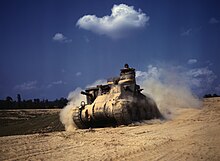Tank
Appearance

A tank is an armored fighting vehicle intended as a primary offensive weapon in front-line ground combat. Tank designs are a balance of heavy firepower, strong armor, and good battlefield mobility provided by tracks and a powerful engine; usually their main armament is mounted in a turret. They are a mainstay of modern 20th and 21st century ground forces and a key part of combined arms combat.


San Juan Hill and Patton's tanks,
And the Army went rolling along
Minutemen, from the start,
Always fighting from the heart,
And the Army keeps rolling along. ~ Harold W. Arberg

Whether the sun smiles upon us,
[Whether in] The day's scorching heat,
Or the ice-cold of the night ~ Kurt Wiehle

But joyful are our minds,
Yes, our minds.
Our tank roars there,
Along in the storm winds. ~ Kurt Wiehle

We remember our brothers in arms ~ Sabaton



A
[edit]- Valley Forge, Custer's ranks,
San Juan Hill and Patton's tanks,
And the Army went rolling along
Minutemen, from the start,
Always fighting from the heart,
And the Army keeps rolling along.- Harold W. Arberg, second verse of "The Army Goes Rolling Along" (1956), added to the music written by John Philip Sousa in 1917.
B
[edit]C
[edit]- Find the reporter, Trombley. If Little Miss Rolling Stone gets run over by an Iraqi tank, Ray's band won't make the cover.
- Sgt. Brad "Iceman" Colbert, Generation Kill, Episode 4: Combat Jack
D
[edit]- We call ourselves the "6th Panzer Army", because we've only got 6 Panzers left.
- Sepp Dietrich in early 1945, as quoted by Mitcham, Samuel W. (2006). Panzers in Winter: Hitler's Army and the Battle of the Bulge. p. 166.
E
[edit]F
[edit]G
[edit]- Der Motor des Panzers ist ebenso seine Waffe wie die Kanone.
- The engine of the Panzer is a weapon just as the main-gun.
- Heinz Guderian, as quoted in Die Deutschen gepanzerten Truppen bis 1945 (1965) by Oskar Munzel, p. 159
- The engine of the Panzer is a weapon just as the main-gun.
- If the tanks succeed, then victory follows.
- Heinz Guderian, as quoted in Panzerkrieg : The Rise and Fall of Hitler's Tank Divisions (2002) by Peter McCarthy and Mike Syron, p. 33
H
[edit]I
[edit]J
[edit]K
[edit]L
[edit]M
[edit]N
[edit]O
[edit]P
[edit]Q
[edit]R
[edit]S
[edit]- We remember the fields, where our tanks held the line
We remember our brothers in arms- Sabaton, "Light in the Black", Attero Dominatus (2006), lyrics by Joakim Brodén & Pär Sundström, music by Brodén
T
[edit]U
[edit]V
[edit]W
[edit]- Whether it storms or snows,
Whether the sun smiles upon us,
[Whether in] The day's scorching heat,
Or the ice-cold of the night,
Dusty are the faces,
But joyful are our minds,
Yes, our minds.
Our tank roars there,
Along in the storm winds.- Ob’s stürmt oder schneit,
Ob die Sonne uns lacht,
Der Tag glühend heiß
Oder eiskalt die Nacht,
Verstaubt sind die Gesichter,
Doch froh ist unser Sinn,
Ja unser Sinn.
Es braust unser Panzer
Im Sturmwind dahin. - Kurt Wiehle, first verse of "Das Panzerlied" ("The Tank Song"), written & composed in 1933. Popular with tank crews of both the Heer (the German Army) and the Waffen-SS (Armed-SS, the military wing of the Nazi Party) prior to and during World War II, the song is widely-remembered in popular culture for its association with World War II-era German tank crews, and was used in war films like Battle of the Bulge (1965).
- Ob’s stürmt oder schneit,
- With thundering engines,
Quick as lightning,
Towards the enemy,
Protected in the tank.
Ahead of our comrades,
In combat we stand alone,
We stand alone.
So we strike deep
Into the enemy's ranks.- Mit donnernden Motoren,
Geschwind wie der Blitz,
Dem Feinde entgegen,
Im Panzer geschützt.
Voraus den Kameraden,
Im Kampf steh'n wir allein,
Steh'n wir allein,
So stoßen wir tief
In die feindlichen Reih'n. - Kurt Wiehle, second verse of "Das Panzerlied"/"The Tank Song" (1933)
- Mit donnernden Motoren,
